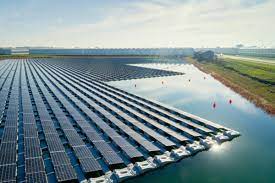Courtesy : en.wikipedia.org
Floating solar energy
Floating solar or floating photovoltaics (FPV), sometimes called floatovoltaics, is solar panels mounted on a structure that floats on a body of water, typically a reservoir or a lake.
The market for this renewable energy technology has grown rapidly since 2016. The first 20 plants with capacities of a few dozen kWp were built between 2007 and 2013.Installed power reached 3 GW in 2020, with 10 GW predicted by 2025.
The costs for a floating system are 20-25% higher than for ground-mounted systems.
Technology features
There are several reasons for this development:
- No land occupancy: The main advantage of floating PV plants is that they do not take up any land, except the limited surfaces necessary for electric cabinet and grid connections. Their price is comparable with land based plants, but floatovoltaics provide a good way to avoid land consumption.
- Installation and decommissioning: Floating PV plants are more compact than land-based plants, their management is simpler and their construction and decommissioning straightforward. The main point is that no fixed structures exist like the foundations used for a land-based plant so their installation can be totally reversible.
- Water conservation and water quality: Partial coverage of water basins can reduce water evaporation. This result depends on climate conditions and on the percentage of the covered surface. In arid climates such as parts of India this is an important advantage since about 30% of the evaporation of the covered surface is saved.This may be greater in Australia, and is a very useful feature if the basin is used for irrigation purposes.
- Increased panel efficiency due to cooling: the cooling effect of the water close to the PV panels leads to an energy gain that ranges from 5% to 15%. Natural cooling can be increased by a water layer on the PV modules or by submerging them, the so-called SP2 (Submerged Photovoltaic Solar Panel). In these cases the global PV modules efficiency rises thanks to the absence of thermal drift.[
- Tracking: Large floating platforms can easily be rotated horizontally and vertically to enable Sun-tracking (similar to sunflowers). Moving solar arrays uses little energy and doesn’t need a complex mechanical apparatus like land-based PV plants. Equipping a floating PV plant with a tracking system costs little extra while the energy gain can range from 15% to 25%.
- Environment control: Algal blooms, a serious problem in industrialized countries, may be reduced. The partial coverage of the basins and the reduction of light on biological fouling just below the surface, together with active systems, can solve this problem. Partial coverage is only a part of the more general problem of managing a water basin generated by and/or polluted by industrial activities.
Floating solar is often installed on existing hydropower.This allows for additional benefits and cost reductions such as using the existing transmission lines and distribution infrastructure.
Challenges
Floating solar presents several challenges to designers:
- Electrical safety and long-term reliability of system components: Operating on water over its entire service life, the system is required to have significantly increased corrosion resistance and long-term floatation capabilities (redundant, resilient, distributed floats), particularly when installed over salt water.
- Waves: The floating PV system (wires, physical connections, floats, panels) needs to be able to withstand relatively higher winds (than on land) and heavy waves, particularly in off-shore or near-shore installations.
- Maintenance complexity: Operation and maintenance activities are, as a general rule, more difficult to perform on water than on land.
History
Installed capacity worldwide in MW
American, Danish, French, Italian and Japanese nationals were the first to register patents for floating solar. In Italy the first registered patent regarding PV modules on water goes back to February 2008.
The MIRARCO (Mining Innovation Rehabilitation and Applied Research Corporation Ontario, CANADA) research group quotes several solutions that were put forward in 2008-2011 and 2012-2014.Most of the installations can be classified into three categories:
- PV plants constituted by modules mounted on pontoons
- PV modules mounted on rafts built in plastic and galvanized steel
- PV modules mounted on rafts, fully in plastic.
A 45 MW combined solar and hydropower plant was installed in Thailand in 2021. A 320 MW facility opened in China in 2022.
Largest floating solar facilities
| This list is incomplete; you can help by adding missing items. (May 2022) |
| PV power station | Location | Country | Nominal Power[22](MWp) | Notes |
|---|---|---|---|---|
| Dezhou Dingzhuang | China | 320 | +100 MW windpower[21][23] | |
| Three Gorges | Huainan City, Anhui | China | 150 | [23] |
| Tata Power Solar | Kayamkulam, Kerala | India | 100 | |
| Ramagundam | Peddapalli, Telangana | India | 100 | |
| CECEP | China | 70 | [23] | |
| Tengeh | Singapore | 60 | [23][24][25] | |
| Sirindhorn Dam | Thailand | 45 | [26] | |
| Sayreville, New Jersey | USA | 4.4 | [27] |




